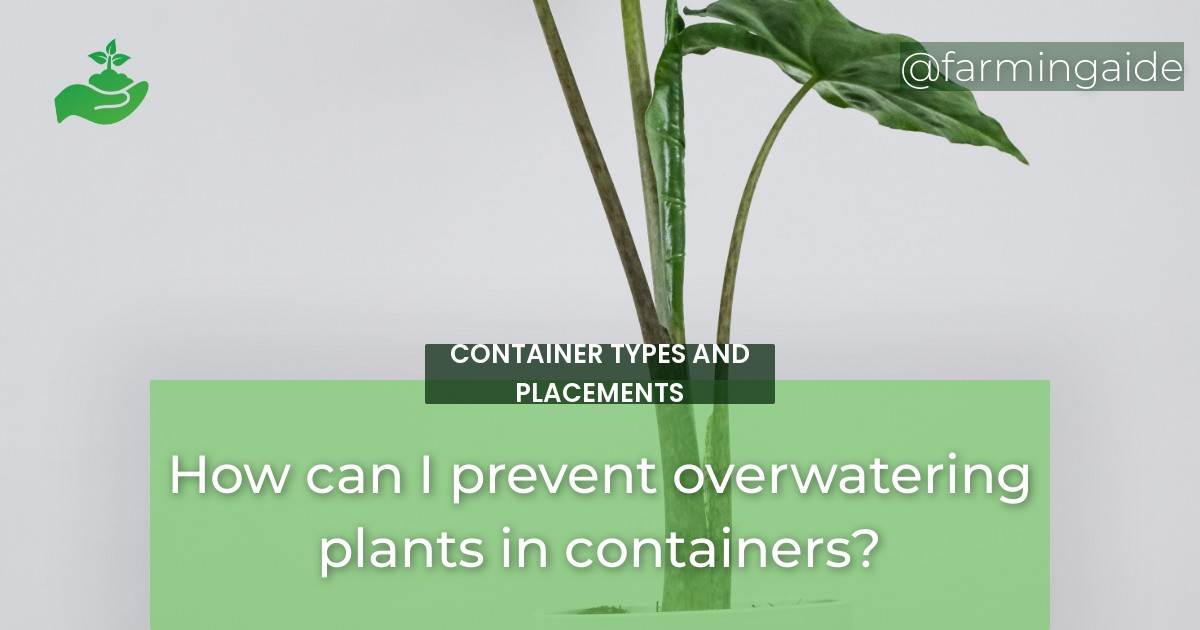Overwatering is a common mistake made by many gardeners, especially those new to container gardening. It can cause root rot, wilting and yellowing of leaves, and even death of plants. However, there are several techniques that you can implement to prevent overwatering and maintain proper moisture levels in container gardening.
Techniques to Avoid Overwatering and Maintain Proper Moisture Levels in Container Gardening
Use the Right Type of Container
- Choose containers with drainage holes to allow excess water to drain out.
- Avoid using containers that are too small for the plant’s roots, as they can quickly become waterlogged.
Choose the Right Soil
- Use a well-draining potting mix that contains perlite or vermiculite to allow water to drain efficiently.
- Avoid using garden soil, which can become compacted and hold onto water.
Provide Good Drainage
- Ensure that the drainage holes in your containers are not blocked by roots or debris.
- Elevate the containers slightly off the ground to allow water to drain freely.
Water Deeply but Infrequently
- Water your plants until the water runs out of the drainage holes.
- Allow the soil to dry out slightly before watering again.
Use a Moisture Meter
- Invest in a moisture meter to accurately gauge the moisture levels in your containers.
- Water your plants only when the moisture level drops below the optimum level.
Monitor the Weather
- Consider the weather conditions when watering your plants.
- Avoid watering during periods of heavy rain or high humidity.
Adjust Watering Based on Plant Needs
- Some plants require more water than others, so adjust your watering schedule accordingly.
- Check the specific watering needs of your plants before watering.
Best Container Types for Preventing Overwatering
Self-Watering Containers
Self-watering containers have a reservoir at the bottom that holds excess water and allows the plant to draw water as needed.
Terra Cotta Pots
Terra cotta pots are porous and allow water to evaporate from the sides, preventing waterlogging.
Fabric Containers
Fabric containers allow for ample drainage and air circulation, which helps prevent overwatering.
Raised Beds
Raised beds provide excellent drainage and allow for easy monitoring of moisture levels.
ALSO READ
Worst Container Types for Preventing Overwatering
Tight or Non-Draining Containers
Containers that are too tight or have no drainage holes can cause water to pool at the bottom, leading to overwatering.
Plastic Containers with No Drainage Holes
Plastic containers can hold onto water and cause root rot if they do not have sufficient drainage.
Placement Tips for Preventing Overwatering
Avoid Placing Containers in Low-Lying Areas
Containers placed in low-lying areas can collect water and cause overwatering.
Provide Shade During Hot Weather
Plants in containers can dry out quickly in hot weather, so providing shade can help prevent overwatering.
Consider the Wind and Sun Exposure
Containers exposed to strong winds or intense sunlight can dry out quickly, leading to overwatering when they are watered too frequently.
ALSO READ
Signs of Overwatered Plants and How to Fix Them
Wilting Leaves
Overwatered plants may have wilted leaves, even if the soil is wet.
Yellowing Leaves
Overwatering can cause leaves to turn yellow and fall off.
Root Rot
Root rot is caused by waterlogged roots and can lead to plant death.
How to Fix Overwatered Plants
Allow the soil to dry out completely before watering again. Repot the plant in fresh, well-draining soil if the root rot is severe.
Is Using Grow Bags a Good Way to Prevent Overwatering Plants in Containers?
Using grow bags for gardening is an effective way to prevent overwatering plants in containers. The porous material allows for proper drainage, preventing water from accumulating and causing root rot. This ensures that plants receive the right amount of water, promoting healthy growth and preventing overwatering issues.
Conclusion
Summary of Techniques and Tips to Prevent Overwatering in Container Gardening
Overwatering is a common mistake in container gardening that can lead to plant death. However, by using the right type of container, choosing the right soil, providing good drainage, watering deeply but infrequently, using a moisture meter, monitoring the weather, adjusting watering based on plant needs, and placing containers in appropriate areas, you can prevent overwatering and maintain proper moisture levels in your container garden. Additionally, knowing the signs of overwatered plants and how to fix them can help you avoid common mistakes and keep your plants healthy and thriving.


